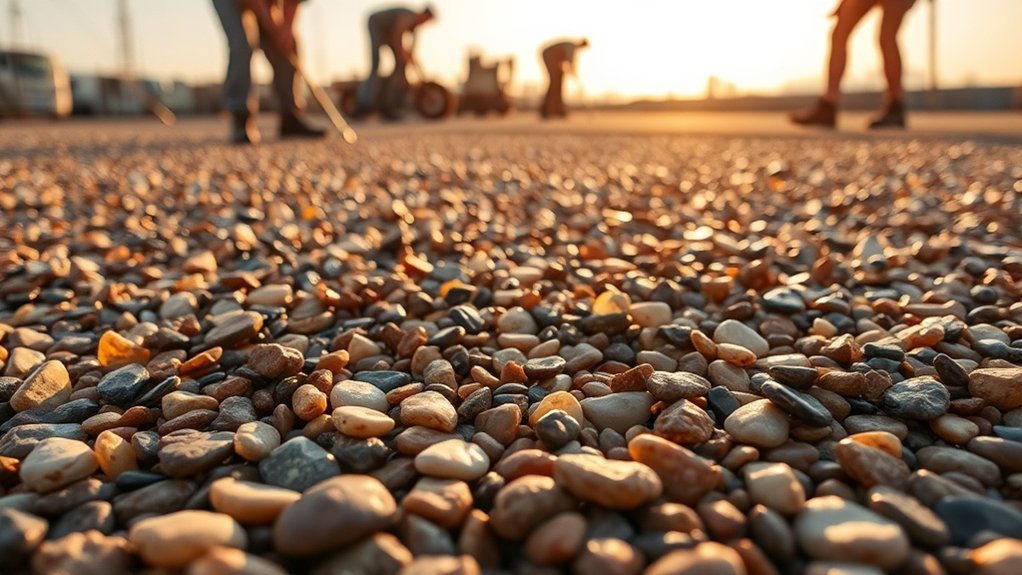Choosing professional resin-bound gravel installations ensures top-quality results thanks to proper base preparation and accurate mixing techniques. Experts determine the right thickness for your specific project, boosting durability and strength. They also keep an eye on weather conditions to ensure effective curing, helping to avoid common installation issues. Additionally, the seamless surfaces created make maintenance simpler and enhance longevity. Interested in learning how these factors contribute to creating an outstanding outdoor space? Read on for more insights.
Key Takeaways
- Professionals prepare the base correctly, choosing stable materials and fixing any defects to ensure optimal adhesion and stability.
- They keep an eye on the weather, only installing when temperature and humidity are just right to ensure effective curing.
- Using forced action mixers, they mix resin and aggregate precisely, achieving consistent strength and colour.
- Experts adjust the thickness based on specific applications, boosting durability and performance for various surfaces.
- Professional installations create seamless surfaces that are eco-friendly, low maintenance, and long-lasting, while also complying with SUDS regulations.
Importance of Proper Base Preparation
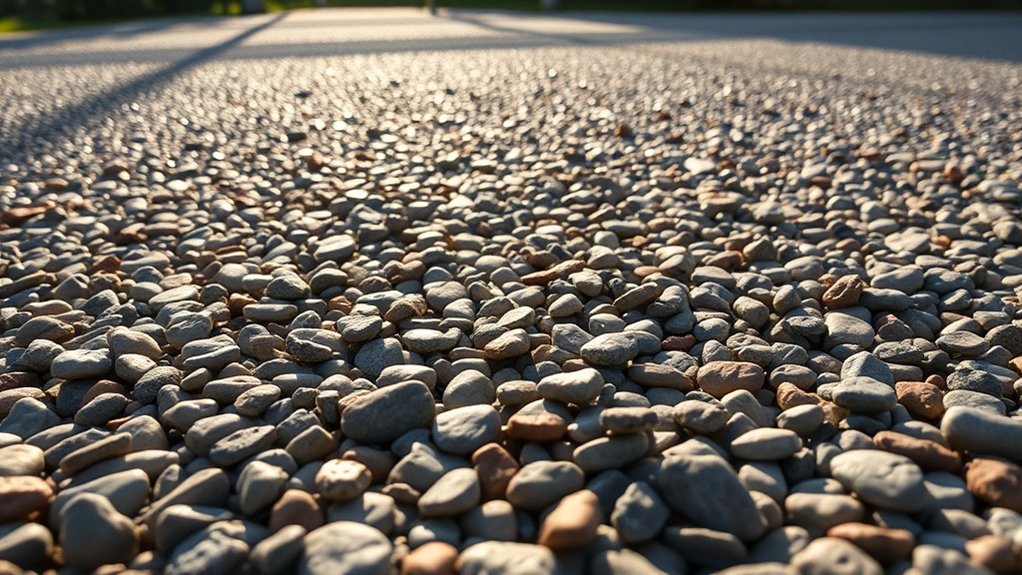
When preparing for a resin-bound gravel installation, ensuring a solid base is crucial for success. Start by selecting appropriate base materials; non-granular options like macadam, asphalt, or concrete are ideal as they provide the necessary stability. A well-prepared sub-base thickness is essential for optimal support under heavy loads.
Before applying the resin, conduct a thorough surface inspection. Remove any debris, dust, and loose particles to ensure proper adhesion. Power washing can help tackle stubborn dirt. Also, check for cracks or uneven areas and repair any defects to maintain stability. If you’re using concrete or asphalt, allow them to cure fully—28 days for concrete and 7 days for asphalt—to avoid moisture issues. Additionally, the base must be clean, dry, and free from debris to optimize bonding with the resin.
Weather Considerations for Optimal Installation
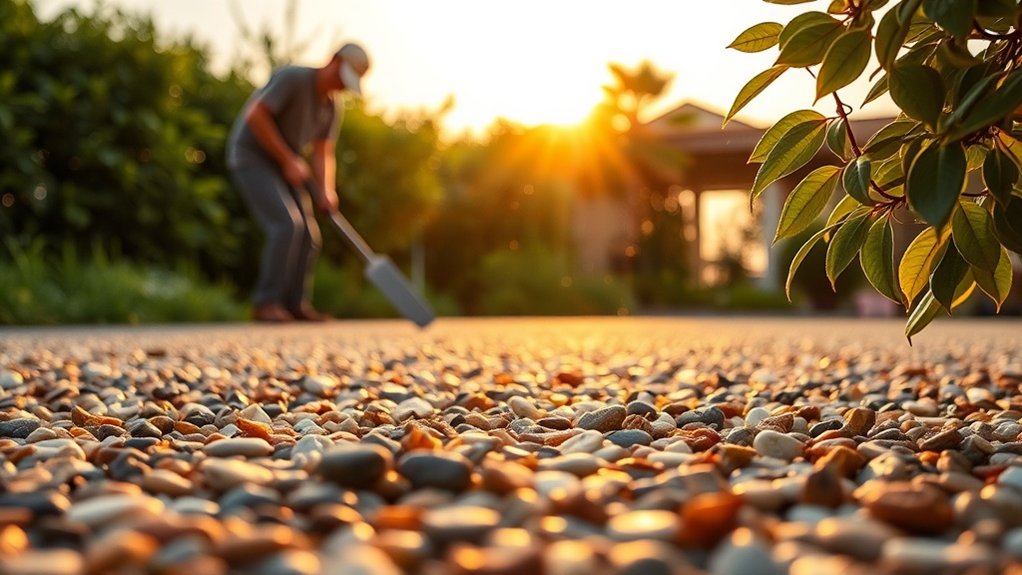
Proper base preparation is crucial for a successful resin-bound gravel installation, but weather can significantly impact the result. For optimal outcomes, aim to install when temperatures are between 5°C and 25°C. This range ensures effective curing without brittleness. Additionally, monitoring weather conditions is essential, as it plays a crucial role in the success of the installation.
Keep an eye on humidity, ideally between 40% and 70%. High humidity can slow the curing process, while low humidity may lead to rapid setting, which can compromise the finish. To ensure durability, choose UV-stable resins that retain flexibility and resist cracking. Avoid installing during rain or damp conditions, as moisture on surfaces can severely affect adhesion. It’s also wise to work during low wind periods to reduce the risk of debris contamination.
Precision in Mixing Resin and Aggregate

Achieving the perfect mix of resin and aggregate is crucial for the durability and performance of your resin-bound gravel installation. To ensure quality, keep these points in mind:
- Precise Resin Dosing: Use resin in quantities between 7% and 15% by weight. This range ensures optimal strength and performance.
- Consistent Mixing Techniques: Employ forced action mixers for a thorough blend, avoiding clumps. Stick to specific mixing times to ensure colour consistency. Proper mixing is vital for complete curing and optimal strength.
- Controlled Environment: Mix on dry, non-porous surfaces to prevent contamination. Maintaining the correct resin to aggregate ratio is essential for long-lasting results.
Be mindful that temperature and humidity can affect resin viscosity and curing time.
Tailored Thickness for Specific Applications
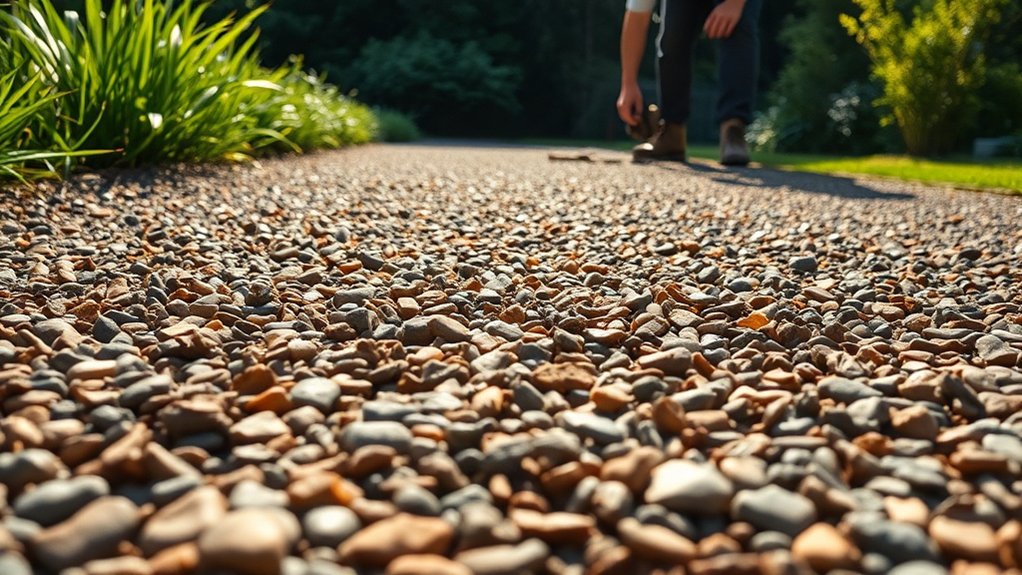
To ensure optimal performance and durability, it’s crucial to tailor the thickness of resin-bound gravel installations for various applications.
For custom thicknesses, consider the size of the aggregates—smaller aggregates, like 3 mm, need a minimum depth of 9 mm, whereas larger aggregates, such as 10 mm, require at least 24 mm.
For driveways, a thickness of 18 mm to 20 mm is standard, but areas with heavier traffic, such as commercial spaces, may need up to 22 mm.
In specialised applications like tree pits, a thicker layer of 40 mm is recommended for stability.
By matching thickness with the intended use and aggregate size, you can enhance the durability of your surfaces.
Always prioritise expert installation for the best results.
Advantages of Seamless and Durable Surfaces
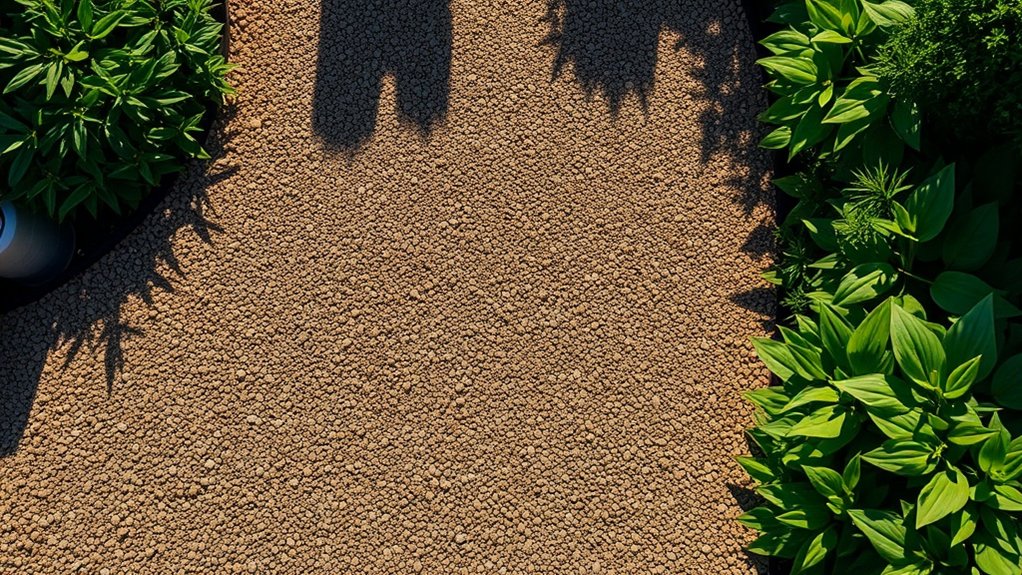
When considering outdoor surfacing options, resin-bound gravel is a standout choice due to its seamless and durable nature, offering several key advantages:
- Easy Maintenance: With no loose stones, upkeep is minimal. The seamless surface also prevents weed growth, making cleaning a breeze.
- Eco-Friendly: Its permeability allows for natural water drainage, meeting Sustainable Urban Drainage Systems (SUDS) regulations and helping to reduce flooding risks.
- Long-Lasting: Properly installed, these surfaces can endure for 25-30 years, standing up to harsh weather and heavy foot traffic while maintaining their appearance.
Opting for resin-bound gravel is a wise decision for those seeking functionality alongside environmental sustainability.
Enhanced Safety Features of Professional Installations
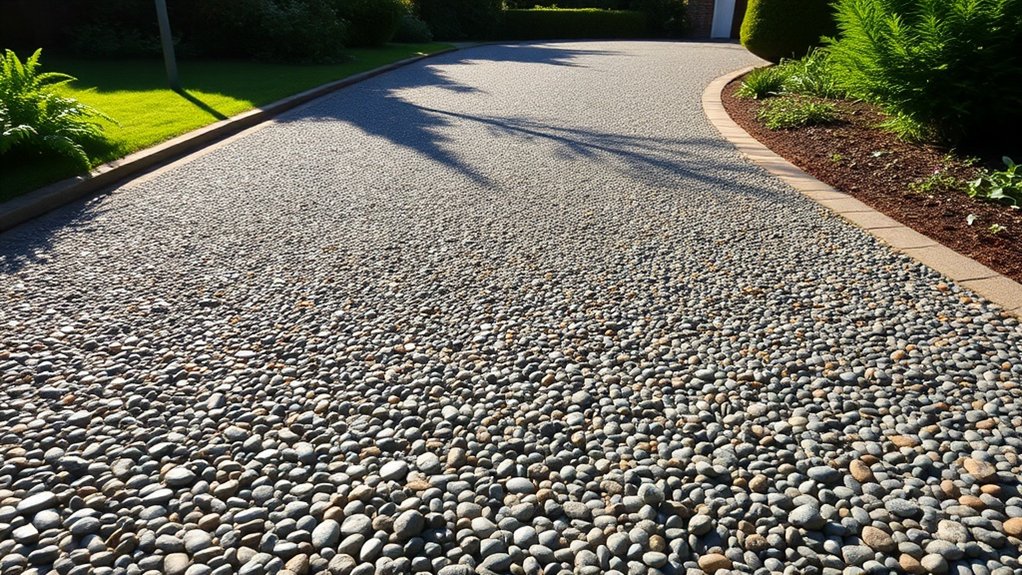
When you opt for professional resin-bound gravel installations, you’re not just getting an attractive surface; you’re also ensuring enhanced slip resistance for safety in all conditions.
With anti-slip materials and tailored textures, these surfaces significantly reduce the risk of trips and falls. Their robust nature also removes common trip hazards, giving you confidence as you move around your space.
Slip Resistance Improvements
When assessing the safety of your resin-bound gravel installation, it’s important to recognise how improvements in slip resistance can significantly enhance user safety.
By focusing on the performance of the resin and the right choice of aggregates, you can ensure your installation meets and exceeds safety standards.
Here are three key factors to consider:
- Testing Standards: Ensure that your installation meets rigorous slip resistance standards, like DIN 51130, aiming for high classifications such as R11 or R12.
- Additives: Adding anti-slip materials, like crushed glass, can greatly improve the slip resistance of your surface, increasing safety.
- Aggregate Choice: Opt for angular aggregates, which not only boost slip resistance but also create a long-lasting, low-maintenance surface that provides grip even in wet or icy conditions.
Trip Hazard Elimination
Improving slip resistance is just one part of ensuring a safe resin-bound gravel installation; eliminating trip hazards is equally important. Professional installations focus on preventing trip hazards through thorough surface inspections and adherence to best practices.
| Factor | Benefits | Implementation |
|---|---|---|
| Permeable Design | Reduces puddles and slips | Ensures effective water drainage |
| Material Selection | Enhances durability | Uses high-quality aggregates |
| Regular Inspections | Identifies hazards early | Carries out routine surface checks |
| Texture Options | Improves grip | Customises surfaces for added safety |
Frequently Asked Questions
How Long Does the Installation Process Typically Take?
The installation process usually takes between 1 to 3 days, depending on the size and complexity of the project. You can expect thorough site preparation and curing phases. It’s best to avoid vehicle access for 24 to 72 hours to ensure optimal results.
Can Resin-Bound Gravel Be Installed Over Existing Surfaces?
Yes, you can lay resin-bound gravel over existing surfaces such as concrete or tarmac, as long as you ensure proper surface preparation. With its durability and aesthetic appeal, resin-bound gravel is a practical choice for your project.
What Colors and Textures Are Available for Resin-Bound Gravel?
You’ll discover a variety of colour options, ranging from warm golds to cool greys, along with different textures. This ensures your resin-bound gravel surfaces can achieve the ideal appearance and feel for any project.
Is There a Warranty for Professional Installations?
Yes, professional installations usually come with warranties that last between 5 to 15 years. These warranties cover issues like defects, UV damage, and cracking, ensuring your investment is safeguarded when installation is done to the proper standards. For example, if you have a new roof fitted, a warranty can give you peace of mind against any installation-related problems for years to come.
How Do I Choose the Right Contractor for Installation?
To choose the right contractor, start by checking their qualifications and experience with installations. Look for relevant certifications, review past projects, and read customer feedback. Ensure they provide detailed quotes and clear contracts to prevent any surprises during your resin-bound installation. For example, if they’ve worked on similar residential projects in your area, it’s a good sign they understand local conditions and regulations.
Conclusion
Choosing professional resin-bound gravel installations is not just about looks; it’s a smart investment in durability and safety. Did you know that a properly installed resin surface can last up to 20 years with little maintenance? This impressive lifespan results from careful base preparation and accurate resin mixing, which create a smooth finish that endures harsh weather. By opting for professional methods, you ensure a stable and attractive surface that boosts both functionality and aesthetic appeal in your outdoor space.
